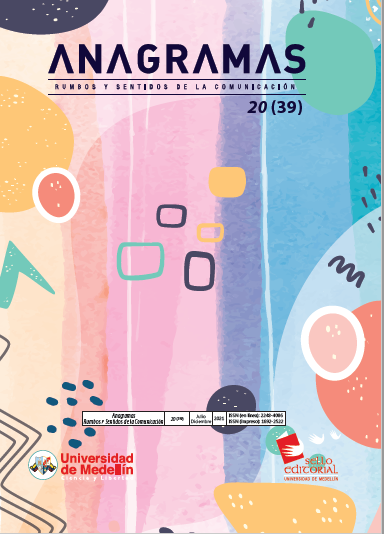Facebook as a Communication Media in Farmers’ Organizations in Catatumbo
Main Article Content
Abstract
This article is an answer to the research titled as Evolution and impact of the Facebook social network as mass media for the Catatumbo farmers’ organizations Ascamcat and Cisca, developed for identifying the dynamics between the use of social media as a tool for broadcasting the activities of these groups, taking into account the importance of their media actions in the subregion of the North of Santander region, the Colombian Catatumbo, therefore its relevance for their inhabitants, who can take profit of this tool for their social progress.
The research gathered qualitative data through observations and semi-structured interviews, giving place
to the comprehension given by the 2.0 Web, and thus determining the dynamics that are a byproduct of the use of Facebook as a communication media by farmer’s organizations of the Catatumbo region, Ascamcat and Cisca.
For the Catatumbo’s Farmers’ Association and Social Integration Committee of Catatumbo, Facebook is a tool that works in three axes: making visible the activities developed by each organization; displaying the realities of each region, integrated by 11 municipalities in North of Santander and redressing the information issued by the national and regional mass media .
Therefore, even though the social network was not created or designed for becoming a mass media, it is, essentially, a window for displaying the realities of the Catatumbo region, redressing in some cases the hegemonic discourse of the traditional media: radio, press and television.
Article Details
References
Ascamcat. (2018). Información de los seguidores de la Asociación Campesina del Catatumbo. [página de Facebook]. Facebook. Consultado el 26 de mayo de 2018. https://www.facebook.com/search/top/?q=ascamcat%20-%20oficial
Becerra, M. (2014). Medios de comunicación: América Latina a contramano. Nueva Sociedad, (249). https://nuso.org/articulo/medios-de-comunicacion-america-latina-a-contramano/
Blanchet, K. (2001). La gobernabilidad y sus críticos. El desarrollo participativo, entre deseos y realidades. Revista Internacional de Ciencias Sociales, (170). http://www.unesco.org/new/fileadmin/MULTIMEDIA/HQ/SHS/pdf/170-fulltext170spa.pdf
Castells, M. (2009). Comunicación y poder. Alianza Editorial. https://www.felsemiotica.com/descargas/Castells-Manuel-Comunicaci%C3%B3n-y-poder.pdf
Cisca. (2018). Información de los seguidores del Comité de Integración Social del Catatumbo [página de Facebook]. Facebook. Consultado el 26 de mayo de 2018. https://www.facebook.com/cisca.comunicaciones/
Colombia TIC. (2018). Estadísticas Puntos Vive Digital en Norte de Santander. https://colombiatic.mintic.gov.co/679/w3-propertyvalue-36366.html
Duarte, F. y Pires, H., F. (2011). Inclusión digital, tres conceptos clave: conectividad, accesibilidad, comunicabilidad. https://revistes.ub.edu/index.php/aracne/article/view/26674
De Certeau, M. (1990). La invención de lo cotidiano. Universidad Iberoamericana Biblioteca Francisco Xavier Clavigero. https://monoskop.org/images/2/28/De_Certeau_Michel_La_invencion_de_lo_cotidiano_1_Artes_de_hacer.pdf
De Ugarte, D. (2007). El poder de las redes. http://www.pensamientocritico.org/davuga0313.pdf
De Pablos C., J. M. (1999) Es que vamos hacia una sociedad de la información. Latina, Revista de Comunicación Social, (14). https://dialnet.unirioja.es/servlet/articulo?codigo=1214182
Facebook. (2021). Misión de la red social virtual Facebook. https://about.facebook.com/company-info/
Gómez M., C. (2015). Nuevas aproximaciones a la teoría de los usos sociales: Prioridades para comprender los procesos de apropiación de las TIC en sociedades diversas. Visiones interdisciplinarias de la diversidad cultural. Colección del Seminario de Investigación sobre sociedad del conocimiento y diversidad cultural de la UNAM. https://www.academia.edu/27589964/Visiones_Interdisciplinarias_de_la_Diversidad_Cultural?auto=download
Harto de Vera, F. (2006). Tipologías y modelos de democracia electrónica. Revista de Internet, Derecho y Política, 2.
Hernández-Sampieri, R., Fernández-Collado, C. y Baptista-Lucio, P. (2014). Metodología de la Investigación. Interamericana Editores
Kaplún, M. (2002). Una pedagogía de la comunicación, el comunicador popular. Ediciones Ciespal. http://www.aader.org.ar/admin/savefiles/352_Mario%20Kaplun.pdf
Max-Neef, M. (1993). Desarrollo a escala humana. Nordan comunidad. http://www.max-neef.cl/descargas/Max_Neef-Desarrollo_a_escala_humana.pdf
Mejía, C., G. (2016). Las organizaciones sociales que mueven el Catatumbo. Verdad Abierta. http://www.verdadabierta.com/victimas-seccion/los-resistentes/6341-las-organizaciones-socialesque-mueven-el-catatumbo
Monterde, A., Rodríguez, A. y Peña-López, I. (2013). La reivindicación de la democracia en la sociedad red, neutralidad de la red, ética hacker, cultura digital, crisis institucional y nueva institucionalidad. Working Paper Series WP13, 004. Internet Interdisciplinary Institute. http://tecnopolitica.net/sites/default/files/1774-6278-4-PB.pdf
Nagel, J. (2012). Principales barreras para la adopción de las TIC en la agricultura y en las áreas rurales. Comisión Económica para América Latina y el Caribe (Cepal). http://repositorio.cepal.org/bitstream/handle/11362/4011/S2012079_es.pdf?sequence=1
Organización de las Naciones Unidas para la Alimentación y la Agricultura (FAO). (1994). Participación Campesina para una Agricultura Sostenible en Países de América Latina. http://www.fao.org/3/t3666s/t3666s04.htm#:~:text=Las%20organizaciones%20campesinas%2C%20tambi%C3%A9n%20llamadas,o%20sociales%20de%20sus%20miembros.
Paquienséguy, F. (2007). Las Tecnologías de la Información y la Comunicación y sus usos hoy. Revista Q, 1(2). https://repository.upb.edu.co/bitstream/handle/20.500.11912/6490/Las%20tecnolog%C3%ADas%20de%20informaci%C3%B3n%20y%20comunicaci%C3%B3n%20y%20sus%20usos.pdf?sequence=1&isAllowed=y
Simon, J. P. (2016). La transformación digital, nuevos agentes en la industria de los medios y contenidos. Revista Telos, Cuadernos de Comunicación e Innovación. https://telos.fundaciontelefonica.com/archivo/numero103/nuevos-agentes-en-la-industria-de-los-medios-y-contenidos/





